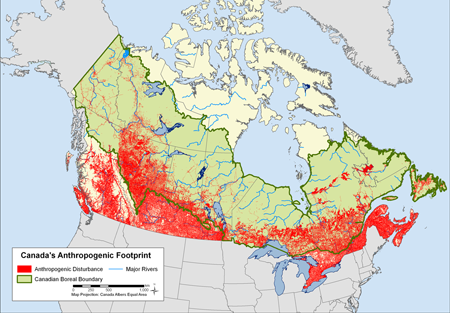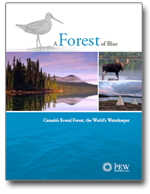
The Mackenzie River in the Northwest Territories. Credit: Irene Owsley
I have had the good fortune to see firsthand some incredible places in Canada’s Boreal Forest. The feeling you get looking out from the shore of a Lake Superior, Great Bear Lake, or Great Slave Lake—all among the world’s largest lakes—is one of awe. The same can be said of some of Canada’s great rivers I have seen like the Mackenzie, St. Lawrence, Athabasca, Slave, Saskatchewan, Albany, and the George among others. Without an exception, all of the regions of the Boreal that I have flown over or spent time in have been dominated by water and wetlands. From the Northwest Territories to Ontario and Quebec, the millions of lakes and ponds, vast peatlands, and thousands of miles of free-flowing rivers and streams reinforce again why Canada’s Boreal Forest is globally significant and why we need to work quickly to ensure it stays that way.
World Water Day, which was on March 22, gave water issues an international spotlight at least for a day but we hope that the waterways and wetlands of Canada’s Boreal Forest will remain the center of attention for much longer than that. In honor of World Water Day, a report was released last week that I co-authored for the Pew Environment Group called “A Forest of Blue: Canada’s Boreal Forest, the World’s Waterkeeper.”
In the reportwe describe how Canada’s boreal—the largest intact forest on Earth—contains 25 percent of the world’s wetlands. The distinctions of this “blue water forest” described in the report are many. It contains 197 million acres of surface fresh water, an area twice the size of California and the largest amount of any single country on Earth. The vast wetlands scattered across Canada’s boreal store 136.7 billion tonnes of carbon and are estimated to provide $700 billion annually in terms of climate mitigation and ecosystem services.

197 million acres of suface fresh water is the largest of any country. Credit: Global Forest Watch Canada
Canada’s Boreal Forest holds the largest concentration of lakes in the world including many of the largest and most pristine on the planet. Great Bear Lake in the Northwest Territories for example is the world’s fifth largest lake and is one and a half times larger than Lake Ontario but it has only a single village of 600 people on its shores. It is considered by some to be the most pristine large lake left in the world.

The small town of Deline is the only community on Great Bear Lake. Credit: Ed Reeves
Not only does Canada’s Boreal Forest still harbor some of the world’s largest rivers like the Yukon and the Mackenzie—rivers on the order of the size of a Mississippi—but unlike most rivers these are still undammed and free-flowing. In contrast, there is only a single large river system is left in the U.S. that is not dammed and impaired. These large free-flowing river systems allow the watersheds of Canada’s Boreal Forest to provide massive flows of freshwater and nutrients to northern oceans that drive ocean currents like the Beaufort Gyre and Labrador Current, and feed marine productivity including commercial fisheries and special creatures like beluga whales, and allow the formation of sea ice that is critical in balancing climate change and supporting polar biodiversity including polar bears.

Boreal rivers provide vital nutrients to marine life, affect currents spanning thousands of miles, and play an important role in sea ice creation. Credit: Genevieve Margherio
While these and many other globally significant values are still found within Canada’s Boreal Forest region, like many areas of the world, industrial activities continue to impact more and more of these resources. Our Pew report describes impacts from forestry, oil and gas and mining, and hydropower as well as from climate change. Already nearly 200 million acres of the boreal lie within the footprint of industrial activity.

The industrial footprint in the boreal is expanding every year. Credit: Global Forest Watch Canada
Fortunately there are also many opportunities across Canada to maintain the values that make Canada’s Blue Water Forest a globally important resource. We outline five broad policy recommendations in the report: 1) support Aboriginal-led land use planning; 2) reform mining legislation; 3) reform hydropower policy; 4) protect carbon-rich peatlands; and 4) implement the Mackenzie Basin Agreement.


